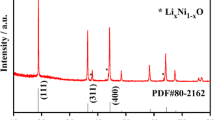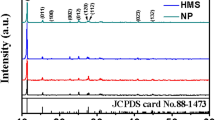Abstract
Submicron rod LiFePO4/C has been synthesized via a facile hydrothermal process. The morphology, crystal structure, and charge–discharge performance of the prepared samples were characterized by scanning electron microscopy (SEM), transmission electron microscopy (TEM), X-ray diffraction (XRD), and galvanostatic charge–discharge testing. The SEM and TEM illustrate that submicron rods with a width of about 140 nm and a length of up to 400 nm have been obtained. The TEM test also indicates a “core–shell” structure with a 1.5–2 nm carbon shell on the LiFePO4 core. Even though the separate carbon-coated procedure is not used in this method, the electrochemical behavior results are satisfied. It displays that LiFePO4/C has highly crystalline and a desirable core–shell structure with uniform carbon film. Galvanostatic battery testing shows that LiFePO4/C delivers 104 mAh g−1 at 5 C rates. The highest specific capacity of 166 mAh g−1 is achieved at 0.1 C rate, and 99.8 % of the initial specific capacitance remained after 30 cycles.







Similar content being viewed by others
References
Armand M, Tarascon JM (2008) Nature 451:652–657
Padhi AK, Nanjundaswamy KS, Goodenough JB (1997) J Electrochem Soc 144:1188–1194
Goodenough JB (2007) J Power Sources 174:996–1000
Manthiram A, Murugan AV, Sarkar A, Muraliganth T (2008) Energy Environ Sci 1:621–638
Bülow JF, Zhang HL, Morse DE (2012) Adv Energy Mater 2:309–315
Kanamura K, Koizumi S, Dokko K (2008) J Mater Sci 43:2138–2142
Ellis BL, Lee KT, Nazar LF (2010) Chem Mater 22:691–714
Islam MS, Driscoll DJ, Fisher CAJ, Slater PR (2005) Chem Mater 17:5085–5092
Fang HS, Pan ZY, Li LP, Yang Y, Yan GF, Li GS, Wei SQ (2008) Electrochem Commun 10:1071–1073
Croce F, Epifanio AD (2002) Electrochem Solid-State Lett 5:A47–A50
Sun CW, Rajasekhara S, Goodenough JB, Zhou F (2011) J Am Chem Soc 133:2132–2135
Zhang WJ (2011) J Power Sources 196:2962–2970
Yi TF, Li XY, Liu HP, Shu J, Zhu YR, Zhu RS (2012) Ionics 18:529–539
Cho YD, Fey GTK, Kao HM (2009) J Power Sources 189:256–262
Dominko R, Bele M, Gaberscek M, Remskar M, Hanzel D, Pejovnik S, Jamnik J (2005) J Electrochem Soc 152:A607–A610
Zhao B, Jiang Y, Zhang HJ, Tao HH, Zhong MY, Jiao Z (2009) J Power Sources 189:462–466
Kong LB, Zhang P, Liu MC, Liu H, Lou YC, Kang L (2012) Electrochim Acta 70:19–24
Wang YG, Wang YR, Hosono EJ, Wang KX, Zhou HS (2008) Angew Chem Int Ed 47:7461–7465
Lepage D, Michot C, Liang GX, Gauthier M, Schougaard SB (2011) Angew Chem Int Ed 50:6884–6887
Dinh HC, Mho SI, Yeo IH (2011) Electroanalysis 23:2079–2086
Wang YG, Li HQ, Xia YY (2006) Adv Mater 18:2619–2623
Tan S, Tieu JH, Qlanger DB (2005) J Phys Chem B 109:14085–14092
Zaghiba K, Julien CM (2005) J Power Sources 142:279–284
Doherty CM, Caruso RA, Smarsly BM, Adelhelm P, Drummond CJ (2009) Chem Mater 21:5300–5306
Ferrari S, Lavall RL, Capsoni D, Quartarone E, Magistris A, Mustarelli P, Canton P (2010) J Phys Chem C 114:12598–12603
Liu H, Li C, Zhang HP, Fu LJ, Wu YP, Wu HQ (2006) J Power Sources 159:717–720
Chang C, Her L, Su H, Hsu S, Yen YT (2011) J Electrochem Soc 158:A481–A486
Acknowledgments
This work was supported by the National Natural Science Foundation of China (no. 21163010), the Key Project of Chinese Ministry of Education (no. 212183), and the Natural Science Funds for Distinguished Young Scholars of Gansu Province (no. 1111RJDA012).
Author information
Authors and Affiliations
Corresponding author
Rights and permissions
About this article
Cite this article
Liu, H., Kong, LB., Zhang, P. et al. A facile hydrothermal method to prepare LiFePO4/C submicron rod with core–shell structure. Ionics 20, 15–21 (2014). https://doi.org/10.1007/s11581-013-0958-2
Received:
Revised:
Accepted:
Published:
Issue Date:
DOI: https://doi.org/10.1007/s11581-013-0958-2




